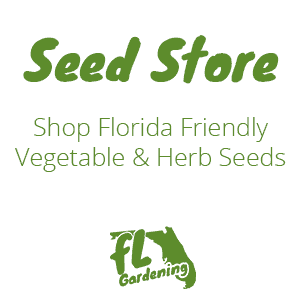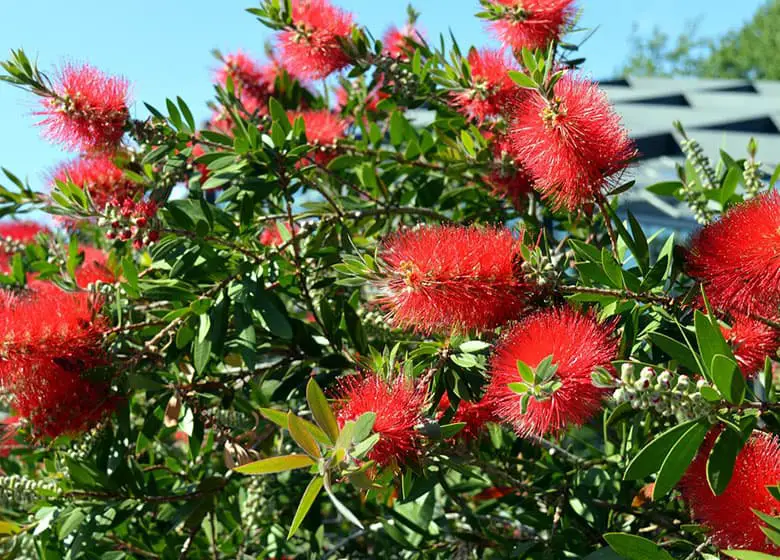
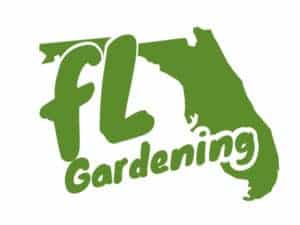
What are some of the Best Plants to Grow For Privacy in Florida?
Azaleas, Bamboo, Bougainvillea, Clusia, Leland Cypress, Podocarpus, and Walter’s Viburnum are some of the best plants to grow for privacy in Florida. These are great privacy plants because they can grow large, and dense while also bringing beauty to your yard.
Whether you live around a pack of nosey neighbors or you’d just like to add a bit of privacy to your Florida landscape, have no fear because you have a wealth of choices in privacy plants. If you want to fill those spaces with year-round greenery or colorful blooms, there are screening plants that will fulfill those desires and your landscape’s design.
Regardless of whether you live along the salty coast, in southern regions of the state where temperatures are the hottest or in North Florida where winters can get cold and frosty, there’s Florida-friendly privacy plants that will thrive in your particular environment.
Continue reading for more details on some of the most common and popular plants used for privacy throughout Florida.
When searching for plants to add a bit of privacy to your yard or even a smaller area around a deck or patio, you won’t be disappointed in all the selections that work well as screens.
Whether that search includes plants offering colorful blooms, tall and robust growth, or something a bit smaller to add a bit of seclusion to a seating area, selections are vast an varied.
Below are some of the most common and popular Florida-friendly plants used to add privacy to areas of the landscape.
A common addition found in older Florida landscapes, Arborvitae (Platycladus orientalis) is hardy growing statewide. Arborvitae shrubs make a big and bold statement used as screens, growing into densely foliaged shrubs covered in scale-like leaves.
It quickly grows up to 20 feet tall and almost as wide, working well in a more formal landscape or used as a specimen. For the best performance, plant the arborvitae in full sun to light shade and in well-drained soil.
It’s tolerant of drought but has a low tolerance to salty conditions and hates to be pruned.
For a nonstop flower show in springtime that fill large evergreen shrubs great for privacy, gardeners in North and Central Florida won’t be disappointed in Southern Indica hybrid azaleas (Rhododendron indicum).
Gardeners have various choices in cultivars that produce an array of different colored flowers in hues of pink, red, white, lavender and purple. These specific azaleas are hardy in Florida’s environmental conditions, growing 6 to 8 feet tall with a similar spread and making a showy screen.
Popular varieties include ‘Southern Charm’ producing pink blooms, ‘George L. Taber’ producing pink blooms with red spots and ‘Formosa’ producing fuchsia/magenta blooms.
For the best performance, grow azaleas in full sun to partial shade and in fertile well-drained soils.
Florida gardeners living in frost-free sections of the state will have no problems with the addition of a bamboo screen in their landscapes. Of the two types of bamboo, running and clumping, clumping types are the easiest to control and won’t aggressively grow out of bounds like running types.
Alphonso Karr (Bambusa multiplex ‘Alphonso Karr’) is a suitable choice for Florida, as it has a clumping habit growing 20 to 35 feet tall and about 10 feet wide.
Alphonso Karr is an attractive bamboo with yellow stalks with a bright green streak down them. It grows best situated in full to partial sun and in fertile well-drained soil. The bamboo is heat, drought and salt tolerant.
Bay laurel (Laurus nobilis) forms into hardy medium to large sized evergreen shrubs averaging around 12 feet tall. You can create a tree form by pruning off lower branches to create a single trunk.
The thick, leathery green leaves are very aromatic and used for culinary purposes. During springtime, small clusters of yellowish-green insignificant flowers bloom and spent flowers on female shrubs change into small blackberries.
This showy shrub performs best planted in full sun to shade and in rich, well-drained soils given regular water applications.
Bay laurel works well grown in containers, planted in mass, or used for a hedge or screening shrub. It’s hardy throughout Florida.

Bottlebrush (Callistemon spp.) is a must have for those wanting a colorful and larger shrub that attracts butterflies as well as hummingbirds in Central and South Florida.
The evergreen produces intense red flower spikes, blooming spring through fall adding color to the landscape almost year-round. Gardeners have choices in an upright and weeping variety that produces the same colorful blooms and the upright form grows up to 20 feet tall and wide, making it suitable used as a hedge or screening plant.
Bottlebrush grows best in full sun and in a variety of well-drained soils and is salt- and drought-tolerant.
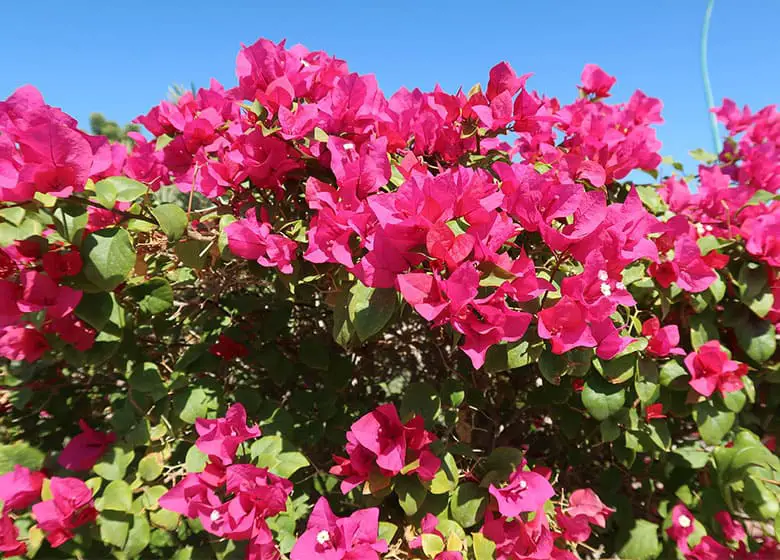
Bougainvillea (Bougainvillea spp.) adds flamboyant color to landscapes in Central and South Florida, offering privacy on several different levels. However, those in colder North Florida can grow it in containers and protect during winter.
The colorful bracts in hues of purple, white, red, pink, and yellow fill the shrubby vine’s canopy throughout the year and are sure to grab attention.
Depending on the variety, evergreen bougainvillea can easily reach heights of over 20 feet with a spread of 40 feet. Its size makes it useful as a screen and its heavily thorn lined branches add to its usefulness of adding privacy.
For the best performance, grow in a sunny site in a variety of well-drained soil. Bougainvillea has a high tolerance to drought and grows well in coastal areas.
Native Florida boxwood (Schaefferia frutescens) works well as a privacy plant for those living in warmer frost-free regions of Florida.
The evergreen offers a bit of color year-round, with the 4-inch oval foliage a yellowish-green, and then in springtime, clusters of greenish-white flowers bloom.
After the blooms fade, small round fruits form starting off as green, changing to yellow and then red.
Florida boxwood grows 15 to 25 feet tall, with a spread of 10 to 15 feet. Grow this salt- and drought-tolerant shrub in partial sun to partial shade and in a variety of well-drained soils for the best growth.
For a densely foliaged shrub that’s both drought- and salt-tolerant, as well as adding a tropical appeal, gardeners living in frost-free regions of Florida cannot go wrong growing Clusia (Clusia spp.).
Thick and leathery, oval green leaves cover plants growing 25 to 30 feet tall and spreading 15 to 25 feet. Clusia rosea, commonly called Pitch-Apple, produces showy 3-inch flowers in pink and white that bloom at nighttime through the summer months. Its large size and dense hardy growth makes it a suitable hedge or screening plant grown in full sun to partial shade and in well-drained soil.
Native Eugenia (Syzygium paniculatum), also call Brush Cherry offers year-round color and is suitable as a hedge or screening plant for those living in frost-free regions of the state.
The dense evergreen grows 12 to 20 feet tall and with a spread of 10 to 15 feet. The small oval foliage is reddish-purple when it emerges, changing to green at maturity.
In summer, the vase-shaped canopy fills with small showy white flowers. For the best performance, grow drought-tolerant Eugenia in partial sun to partial shade and in well-drained soils.
Another staple of southern gardens, with taller varieties suitable used as hedges and screens, gardenia (Gardenia jasminoides) performs well statewide.
Although known for the large waxy white flowers that fill a garden with their sweet fragrance, the glossy green evergreen leaves are quite attractive, especially when the shrub isn’t blooming.
Plants can reach a mature height of 8 feet and with a similar width. Gardenia grows best in fertile, well-drained soil and situated in partial sun to partial shade.
Jatropha plants work well as hedges or screening shrubs, as well as offering a year-round brilliantly colored display of clusters of bright red or pink flowers that will have hummingbirds and butterflies visiting your garden. Mature plants grow up to 15 feet tall and wide.
The two common species of this evergreen shrub or small tree that are hardy growing in South and Central Florida are Jatropha integerrima, commonly called peregrine and Jatropha multifidi, better known as coral plant.
Although they flower best grown in full sun, they also tolerate growing in partial shade and in a variety of well-drained soils.
Hardy throughout Florida, Leyland cypress’ (Cupressocyparis leylandii) large and towering size of up to 50 feet tall and 25 feet wide, make it best suited for larger landscapes where it can naturally spread out.
It quickly forms into a pyramidal form covered densely in bluish-green scale-like and evergreen foliage.
Its towering and majestic size definitely will make a statement, working well as a hedge or large screening plant.
It has a high drought-tolerance and moderate tolerance to salt, growing well in full sun to partial shade and in a variety of well-drained soils.
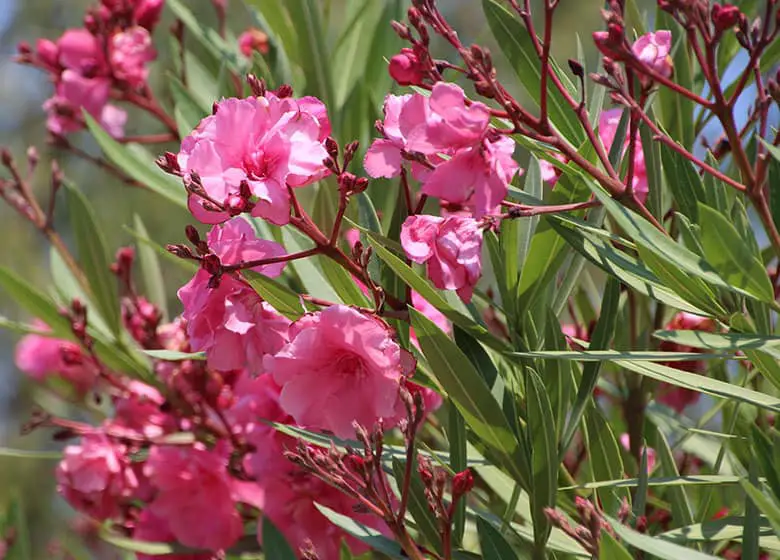
Another attractive and flowering staple to southern gardens that is hardy in Central and South Florida is the fast-growing Oleander (Nerium oleander).
The low-maintenance evergreen shrub brightens gardens with its almost year-round flowers and makes an attractive and colorful screen or hedge. Oleander has a mounding shape with long branches covered in long, dark green foliage.
Clusters of brightly colored flowers cover the shrub most of the year and range in colors of white, pink, yellow, red or coral and can be single or double, depending on the cultivar.
The shrub grows 10 to 18 feet tall, spreading about 10 feet, and dwarf cultivars average 4 feet wide and tall. This durable shrub is heat-, salt- and drought-tolerant, growing in even the poorest well-drained soils and thrives in full to partial sun.
All portions are toxic.
With its dark green and narrow leaf blades forming into a dense mass, Podocarpus (Podocarpus macrophyllus), also called yew Podocarpus makes an attractive hedge or privacy screen for gardeners throughout the state.
The evergreen also performs as a tree, growing up to 40 feet tall and 20 feet wide. The yellow flowers are barely noticeable, but the small fleshy fruits that are a bluish to purplish-red add additional interest against the dark green foliage.
Podocarpus has a high tolerance to drought and salt, performing best in full sun to partial shade and in well-drained soils.
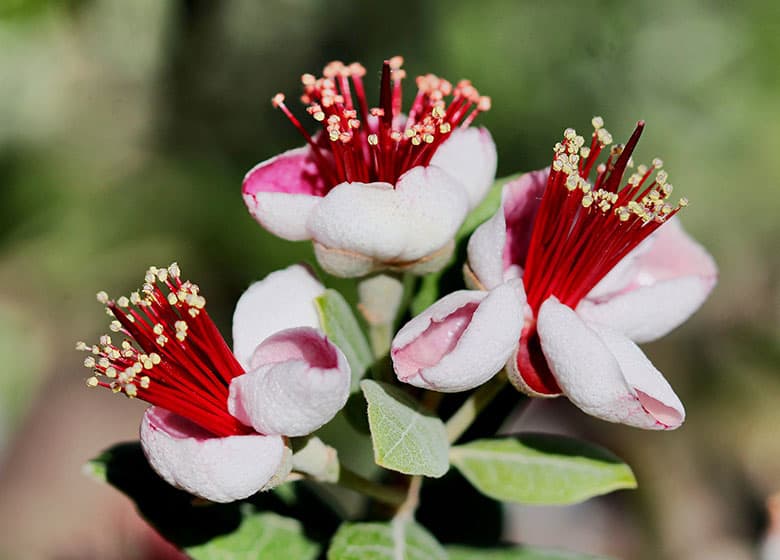
Pineapple guava (Acca sellowiana) is a good choice for those wanting an attractive flowering shrub that offers the bonus of edible fruit, as well as making an attractive hedge or privacy screen.
This durable and low-maintenance shrub is hardy throughout Florida, growing up to 15 feet tall and wide. Plants are covered in egg-shaped silvery and green evergreen foliage and in spring, 2-inch flowers form with pink or white fleshy petals with noticeable red stamens, which form into egg-shaped fruits.
Fruits ripen in late summer through early fall. It grows best in full sun to partial shade and in well-drained acidic soil. Plants are salt- and drought-tolerant.
Those in Central and South Florida looking for a tropical and robust growing privacy plant that’s not only salt-, drought- and wind-tolerant, but also offers the bonus of edible fruit should look no further than a sea grape (Coccoloba uvifera).
This attractive native evergreen’s canopy fills with large 8-inch diameter round leaves that are green and leathery until winter when they change to red. In springtime, following the inconspicuous white flowers, clusters of grape-like fruits form changing from green to purple in summer that are edible.
Multi-branched sea grapes grow into large plants, growing up to 50 feet tall and a spread of 20 to 30 feet. These hardy plants grow in full sun to partial shade and in a variety of well-drained soils.
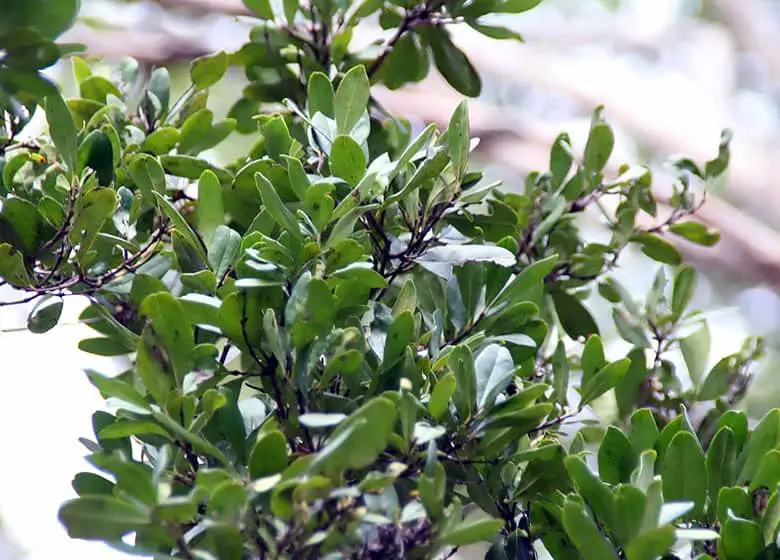
Simpson’s stopper (Myrcianthes fragrans) is a Florida native that offers a wealth of attributes like fragrant flowers, colorful berries, evergreen foliage, as well as being low-maintenance and salt- and drought-tolerant.
Showy white flowers bloom in spring, followed by red berries, with both attracting various birds and butterflies. An additional showstopper is the exfoliating bark.
The shrub can grow 20 feet tall and almost as wide making it suitable used as a hedge or screening plant.
It prefers growing in a wide range of soils, including the poorest and in full sun to partial shade. Simpson’s stopper grows best in South and Central Florida.
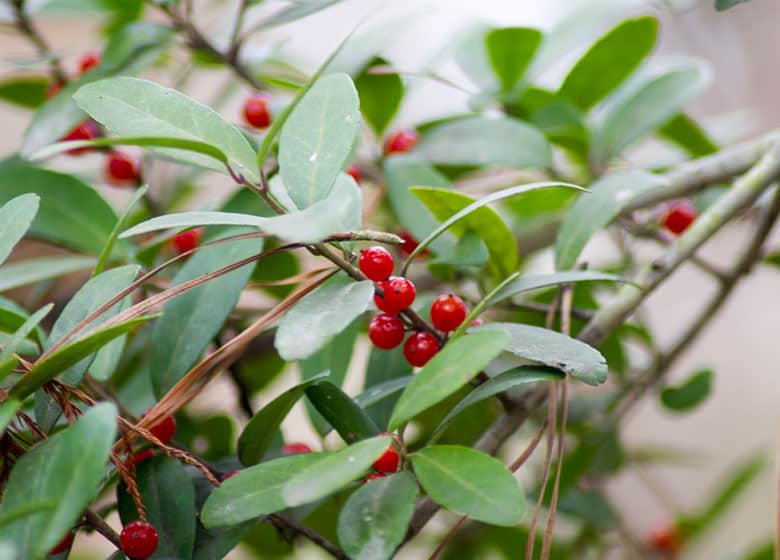
Hardy in North and Central Florida, yaupon holly (Ilex vomitoria) develops into a large shrub growing around 15 to 25 feet tall and wide, making it a suitable choice used to add privacy to the landscape.
Although both male and female plants produce small insignificant flowers in springtime, only the females then produce the brilliantly red tiny berries that cover the plants starting in summer.
The holly is a hardy plant, tolerating drought and salty conditions, as well as thriving in full sun to shade and in a variety of well-drained soils.
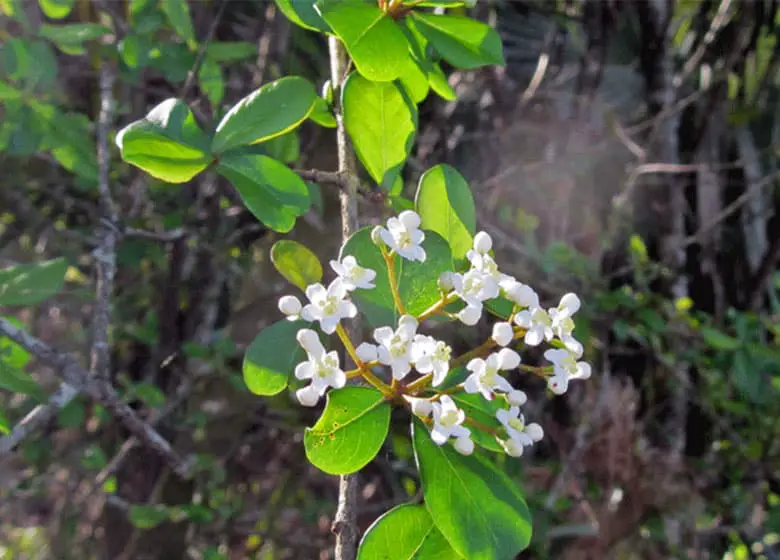
Hardy throughout Florida, native Walter’s viburnum (Viburnum obovatum) is an attractive evergreen shrub sporting fragrant foliage and covered in a mass of white flowers in mid-winter, and followed by red to black fruits that are highly desired by birds.
The Florida native grows up to 20 feet tall with a spread of about half the height and is useful as a privacy hedge or screening plant.
This durable and low-maintenance shrub is drought-tolerant, thriving in full to partial sun and in well-drained soils.
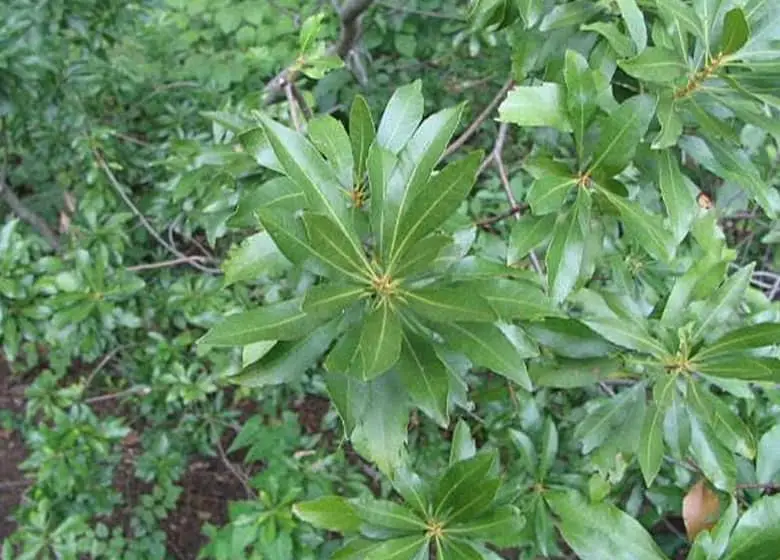
Wax myrtle (Myrica cerifera) is a native evergreen shrub thriving statewide and gets its common name from the clusters of bluish-gray waxy berries that once were utilized in candle making.
Growing up to 25 feet tall with a similar width, wax myrtle works well as a hedge or privacy screen. The shrub has a rounded shape, is covered in dense, aromatic and evergreen leaves.
This tough and easy to grow salt- and drought-tolerant shrub tolerates a range of conditions from full sun to partial shade and wet soils to those that are dry.
Works well as a screden, hedge, specimen, accent plant, wildlife gardens or grown in containers.
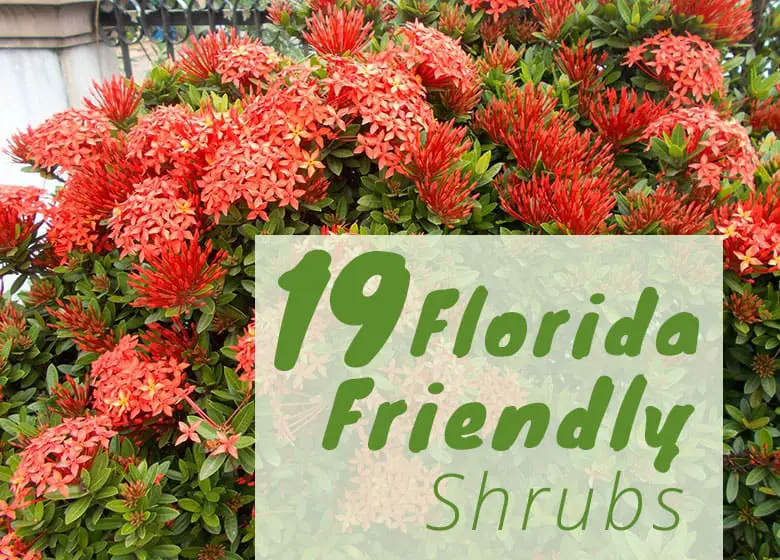
I've been gardening in Florida since 2014. I'm an FNGLA certified horticulturist and a Permaculture design apprentice. I just want to share my love and passion of growing plants with other in the state of Florida to help them grow beautiful gardens.
Unlike those living in the North, Florida homeowners can enjoy a beautiful lawn year-round. It’s one of the benefits of living in a year-round, subtropical climate. Growing a beautiful lawn in.
Gardeners have a wealth of choices in ground covers that are hardy growing in all areas of the state. Ground covers can add color, texture and an interesting appeal to the garden. Beach Sunflower.
My name is Josh and I love to garden. I was born in Tampa and have never left Florida. Unluckily for plants, I really enjoy growing them. I've grown a few plants over the years. I've also killed a few plants over the years, more than I would like to admit. I just want to share my experience and hope that it helps others.
This site is owned and operated by Joshua Kipp Enterprises. Joshua Kipp Enterprises is a participant in the Amazon Services LLC Associates Program, an affiliate advertising program designed to provide a means for sites to earn advertising fees by advertising and linking to Amazon.com. Joshua Kipp Enterprises also participates in affiliate programs with Bluehost, Clickbank, CJ, ShareASale, and other sites. Joshua Kipp Enterprises is compensated for referring traffic and business to these companies
